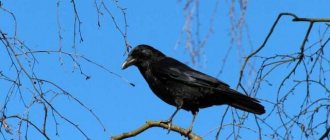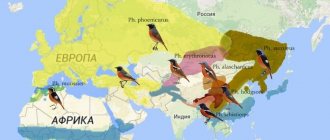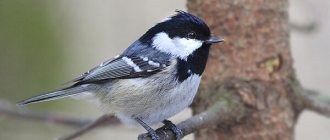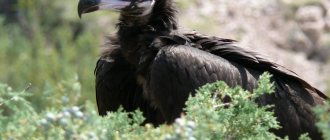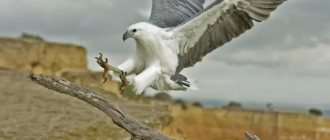| Latin name: | Nucifraga caryocatactes |
| English name: | To be confirmed |
| Kingdom: | Animals |
| Type: | Chordata |
| Class: | Birds |
| Squad: | Passeriformes |
| Family: | Corvids |
| Genus: | Kedrovki |
| Body length: | up to 30 cm |
| Wing length: | To be confirmed |
| Wingspan: | To be confirmed |
| Weight: | 125—190 g |
Description of the bird
The nutcracker is a small bird with a thin and long beak. The bird's body length is up to 30 cm, the tail length is about 11 cm. The weight of adult individuals ranges from 125 to 190 g. The plumage of the nutcracker is dark, brownish-brown in color with white spots that are absent on the upper side of the head. The end of the tail is framed by a light border. The female is practically no different from the male; she is a little lighter in plumage color, and her white spots are not so sharply defined.
Population and species status
Coniferous forests, within which these birds are found, are most susceptible to various man-made and natural disasters. These forests are highly flammable, leading to severe fires, and are also subject to uncontrolled logging, which leads to the loss of natural habitats. Naturally, such negative factors have a decisive impact on the populations of these birds, reducing their numbers. Despite the presence of such negative aspects, the number of these birds remains at a level where it can be considered that they are not in critical condition and are not in danger.
Such conclusions from experts inspire optimism, but this does not mean that people should not take care that nutcrackers are not on the verge of extinction. Recently, people are increasingly introducing themselves into the natural environment, which cannot but have a negative impact on the populations of many birds, including nutcrackers.
Kedrovka and interesting facts about it
Nutritional features of nutcracker
— Advertising —
The basis of the diet of nutcrackers is ripened pine nuts, as well as acorns, beech nuts, spruce and pine seeds, berries, small vertebrates and insects.
Pine nuts remain the favorite food of all nutcrackers. As soon as they begin to mature, the birds gather in flocks and go to the forest to collect food. Nutcrackers work from morning to evening to make sufficient supplies of nuts for the entire frosty, snowy winter, both for themselves and for their offspring.
During the short Siberian summer, one nutcracker manages to collect about 70,000 pine nuts. The bird carries more than 100 nuts at a time; for this purpose it has a special sublingual pouch. But, in addition to directly collecting, the nuts must be transferred and hidden in safe places. Hiding all the collected food in one hole or hollow for nutcrackers is too risky, because hares, field mice, and bears can feast on tasty and nutritious pine nuts in winter. Therefore, the nutcracker makes many hiding places, perfectly remembering their location.
Features of character and lifestyle
Photo: Nutcracker bird
The lifestyle of this forest bird differs at different times of the year. During nesting, she finds secret corners in the forest thicket and rarely leaves this small territory. If at this time a person accidentally comes close to this place, then the bird quickly hides, burying itself in the tops of trees.
At other times of the year, these birds are quite sociable, are not at all afraid of people and can stay close to housing, knowing that there is always something to eat there. Most often, nutcrackers can be seen on the edges and clearings, along the edge of the forest, along forest rivers and streams.
Interesting fact: Nutcrackers, like other nutcrackers, are very inventive. Ornithologists observed how they caught pine moth caterpillars in November right from under the snow, making oblique passages in the snow cover.
Birds usually sit on the lower branches of trees, extracting seeds from cones. If they notice danger, they can fly up almost silently and hide in the top of one of the nearby trees. Sometimes a bird can let a person get very close.
Nutcrackers make interesting sounds. They can be compared to the cry of a crow, but not so loud, it is more like the cry of a jay. Their calls may sound like “cray-cray”; if they are very worried, scared, then “kr-kr-kr”. Sometimes a set of sounds can even be called a semblance of singing.
Bird distribution
— Advertising —
The habitat of the nutcracker includes taiga-type forests in Europe and Asia, ranging from Scandinavia and the Alps to Kamchatka, the Kuril Islands, Primorye, Japan and China. In Siberia, the nutcracker is the only widespread distributor of cedar (Siberian pine). The bird inhabits mainly spruce forests, as well as cedar and cedar-schist forests. It is in coniferous forests that the nutcracker's main food—seeds of pine, spruce and cedar cones—is sufficient.
The nutcracker prefers to live on land and rarely crosses bodies of water more than 3 km wide. A bird can get to the islands along with a typhoon or storm, and stay there.
Nutcrackers lead a mostly sedentary lifestyle, since the food reserves they make for the winter allow them to survive the cold without migrating in search of food.
If in the Siberian taiga there is a failure in the harvest of pine nuts and seeds of coniferous trees, then nutcrackers fly en masse to the west to find new sources of food. In such lean years, large flocks of nutcrackers are found in Eastern and Central Europe.
WHAT DOES IT EAT?
Nutcrackers feed on insects, small vertebrates, fruits, berries, and seeds. The seeds of coniferous trees and the nuts they feed on are much higher in calories than insects. Insects, like food of animal origin, contain a lot of protein, but to survive in the frosty winter, birds need energy, which they get from carbohydrates. Nutcrackers that live in the south of the Scandinavian Peninsula feed mainly on hazelnuts. In other places, birds eat the seeds of coniferous trees—alpine nutcrackers, for example, love pine nuts. Obtaining tasty seeds from cones and nut kernels is not a difficult task for nutcrackers. She takes out seeds from the scales of cones with a thin long beak, and smashes the nuts against a tree or stone. Some birds, as a result of prolonged feeding on the seeds of certain plants, have developed a special beak shape. Nutcracker chicks need animal protein, so their parents feed them insects.
Common types of nutcracker
North American Nutcracker (Nucifraga columbiana)
The bird's body length is from 27 to 30 cm. The plumage is ash-gray, except for the black-and-white wings and central tail feathers. The beak and paws are black.
The species is common in the pine forests of the Rocky Mountains. It feeds mainly on the seeds of various types of pine, which it hides throughout the year, making reserves for the winter. The North American nutcracker builds its nests on the tops of pine trees.
Natural enemies
The greatest danger to nutcrackers during nesting is their natural enemies - small predators. At this moment, adult birds also become easy prey, but most often their chicks or clutches of eggs. The most dangerous predators are weasels, martens, foxes and wild cats.
Important! Considering that the nutcracker is difficult to climb and takes off rather slowly, it has no chance of escaping from the teeth of a marten or a fox.
Most often, the nutcracker becomes an easy prey when it digs up nuts that it has stored for future use . Then the bird loses its vigilance, sees and hears poorly, and becomes practically defenseless even against a small predator.
Return to content
Reproduction of nutcracker
Nutcrackers are monogamous birds that form one pair for life. During the mating season, the birds try not to be seen by anyone and lead a secretive lifestyle within the confines of their strictly defined nesting territory.
A nutcracker's nest is a chaotic heap of twigs, grass, moss, and lichens, which the bird holds together with clay. Such nests are located on coniferous trees at a height of 4 to 6 m above the ground. Since the nutcracker has its own sufficient food reserves in winter, the bird begins nesting early. Thus, nutcrackers begin to build a nest when there is still snow and the air temperature is below zero.
In March or April, the female nutcracker lays 3-4 oblong pale green eggs. Both partners take turns incubating, since the male does not know where exactly the female made her reserves.
Newborn nutcracker chicks are fed seeds, which are previously softened in the crop. When the reserves made for the winter run out, nutcrackers bring insects to their chicks.
At the beginning of June, young birds begin independent life, but their parents feed them for several more months.
Social structure and reproduction
Photo: Kedrovka in the forest
Nutcrackers can be called social birds, except during nesting time. If you notice one bird, there is always a chance to see several more nearby. Pairs form at the end of winter, and nesting sites are established before the snow finally melts. The nest of this forest dweller can be found extremely rarely, only in the most remote thickets; if at this time a person encounters a nutcracker, it tends to elude him unnoticed. Depending on climatic conditions, these birds, both female and male, are engaged in building their nest from March to May.
This is a fairly large structure, about 30 cm in diameter and up to 15 cm in height. At the same time, the tray is quite small: about 10-15 cm in diameter. The nest is located high on spruce or other coniferous trees, in the place where the branch leaves the trunk. Dry branches of conifers covered with lichen are placed at its base, the next layer is birch branches, the nest is lined with grass, fibers from under the bark, all this comes with a clay admixture, and the top is covered with dry blades of grass, moss, and down.
Birds lay from 3 to 7, but most often 5 eggs of bluish-white or fawn color. Along the main background of the shell are olive or smaller violet-gray speckles. Sometimes there are few inclusions and they are collected at the blunt end. The oblong-shaped eggs are about three centimeters long, with a cross section of two and a half centimeters.
Both parents participate in incubation. The chicks hatch after 19 days. First they are fed insects and berries, nut kernels. After three weeks, the chicks already fly out of the nest and are able to obtain food on their own. But even the smallest birds no longer hide, shouting to greet their parents bringing food, and even adult birds with desperate cries rush at anyone who encroaches on their offspring. After the chicks hatch, the older birds moult. When the babies get stronger, nutcrackers move in flocks from remote places to more open ones. Sexual maturity in these birds occurs at one to two years.
Interesting facts about the bird
- The nutcracker's stomach can hold up to 12 nuts. But in the fold under the beak - 10-15 times more, which is an excellent adaptation for carrying nuts over long distances. The pine nuts are buried in the soil within a radius of 2 to 4 km from the cedar, due to which the natural spread of this unique tree occurs. However, it is not known exactly how nutcrackers manage to find their hiding places. Perhaps the birds are guided by smell, but this method will not work in heavy snowfalls. It is likely that birds are able to remember the places where they make their “storerooms”.
- In 2013, a monument to the nutcracker was unveiled in the Siberian city of Tomsk.
Lifestyle and habitat
The native home of the nutcracker is, consonant with its name, cedar forests, but also spruce and other coniferous forests. This bird is not particularly attracted to water spaces, and it does not even try to cross rivers more than 3 km wide. But sometimes it happens that storms and typhoons carry such creatures to remote islands, where they take root and remain as permanent inhabitants.
Such a winged creature is not particularly capable of other journeys, especially long ones, especially if it is not necessary. This is not a migratory bird. Kedrovka leads a sedentary lifestyle. And in order to survive in cold times, it makes very extensive reserves of seeds and nuts for the winter - its favorite food.
And only in years when there are crop failures in the Siberian forests for various reasons, extensive fires occur there, or trees suffer from predatory felling, such birds from there in large numbers go to the west to find additional sources of food.
During such periods, entire flocks of migrated birds catch the eye of people in Central and Eastern Europe. This is where the nutcracker lives until better times come. By the way, in the old days in these parts, numerous groups of these birds, appearing from nowhere, were considered a harbinger of great misfortunes.
Superstitious European residents of past centuries, unable to find a correct interpretation of the invasion of flocks of nutcrackers, associated them with famine, wars and plague.
Such a small birdie, of course, has plenty of enemies in nature. Small predators can pose a particular danger to her during the nesting period: wild cats, foxes, martens, weasels. Taking advantage of the helplessness of such birds, who are entirely occupied with the troubles of breeding and raising offspring, they attack them and also feast on their eggs and cubs.
Such attempts are often successful because nutcrackers are by nature very slow, not always agile, they are difficult to climb and rise into the air quite slowly.
Birds are also vulnerable during periods when they make abundant reserves for the winter. At such times, they have the habit of completely losing their vigilance, they don’t hear or see anything around them, and therefore they unusually easily become victims of their clever and cunning enemies.
Capercaillie
Capercaillie is a resident of forest thickets. This is a big forest rooster. In the summer, when blueberries, lingonberries, and blueberries ripen, the capercaillie feeds on berries. And on the banks of streams, wood grouse peck small pebbles so that the pebbles in their stomachs, like millstones, grind the berries. In winter, capercaillie feeds on pine needles.
The millstone stones grind them down. In the spring, as soon as the snow melts in the forest, wood grouse begin to talk - to sing their spring songs. The capercaillie walks on the ground like a turkey, spreading its tail like a fan, and clicking its beak, as if two sticks are knocking against each other. And the song ends as if a knife is being sharpened on a whetstone. At the end of the song, the wood grouse goes deaf, which is why it was called the wood grouse.
GENERAL PROVISIONS
In Ukraine, it is called hazelnut - because due to the lack of cedar pines, nutcrackers here feed on hazel seeds.
A small bird, no larger than a jay, from the corvid family. It is found in mixed and coniferous forests of Eurasia, most of all in cedar forests. Pine nuts are the main food of the nutcracker all year round. In fruitful years, the nutcracker extracts seeds from the cones and hides them in the most secret places, and then lives for a long time at the expense of supplies, since cedar pines do not bear fruit every year. It has now been established that birds are the main friend of cedar pines, since a significant part of the seeds hidden by nutcrackers in the ground germinate. In addition, birds carry seeds over a considerable distance. Other animals, including bears, also use the supplies of nutcrackers. They feed the chicks with insects and crushed seeds.
Notes[ | ]
- Boehme R. L., Flint V. E.
Five-language dictionary of animal names. Birds. Latin, Russian, English, German, French / Under general. ed. acad. V. E. Sokolova. - M.: Russian language, RUSSO, 1994. - P. 471. - 2030 copies. — ISBN 5-200-00643-0. - The discovery of dwarf cedar on the island of Matua (Kuril Islands) - the topic of a scientific article on biology, read the text of the research paper for free in the electronic library...
- Notes about the birds of the Kuril Islands - the topic of a scientific article on biology, read the text of the research paper for free in the CyberLeninka electronic library
- ↑ 1 2 3 4 5 6 7 8 Vekhov N.
Kedrovka - a wonderful taiga “forester” // Ural Pathfinder. — 2022. — No. 6 (756). — P. 33. - ↑ 1 2 3 4 5 6 7 8 9 10 11 12 Vekhov N.
Kedrovka - a wonderful taiga “forester” // Ural Pathfinder. — 2022. — No. 6 (756). — P. 32.


